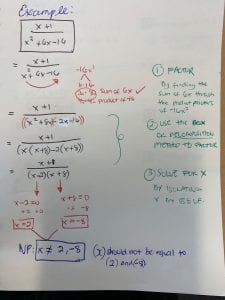This week in Precal we learned about rational expressions, which just means fractions with variables Furthermore, we learned about determining the Non-Permissible Values – which means that the denominator can NOT be equal to zero or else it would be undefined so, we would have to have restrictions for variables that prevent the denominator to be equal to zero. Also, we learned about simplifying rational expressions, multiplying and dividing rational expressions, as well as adding and subtracting rational expressions with monomial denominators.
How to determine the non-permissible values of the variable:
-In order to find out the NP values, we must solve for x (or any variable) that is ONLY in the denominator since we don’t have to worry about having a zero on the numerator.
Example:
We must factor first, then when we find out the factored form of the denominator, we must solve for x in order to find out the x value that should not equal to zero for the denominator since we cannot have zero on the denominator or else it would be undefined.
Simplifying Rational Expressions
Multiplying Rational Expressions: When multiplying rational expressions, it’s actually easy since we can do cross-cancellations to simplify easier and efficient.
Dividing Rational Expressions:
Key thing when dividing rational expressions with regards to non-permissible values. After reciprocating the second fraction and everything is factored, we find the NP values for the numerator and denominator on the second fraction since we reciprocated.
Example:
Another example:





Be First to Comment